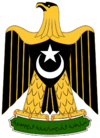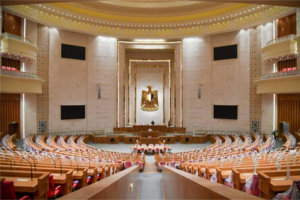Onhsanenea
Republican Sultante of Onhsanenea 2 official names
| |||||
|---|---|---|---|---|---|
| Anthem: Battle Hymn of the Sultanate | |||||
 | |||||
| Capital and largest city | Wahhata | ||||
| Official languages | Classical Arabic Onhsanenean | ||||
| Recognised regional languages | Yawathan Dilanian | ||||
| Ethnic groups (2022) |
| ||||
| Religion (2018) |
| ||||
| Demonym(s) | Onhsanenean | ||||
| Government | Federal constitutional parliamentary Islamic sultante | ||||
• Sultan | Tekanawí:te Al-Khanenharon II | ||||
• Wazir | Karonhiarake Teyothenserah | ||||
| Kenhnonwe Kateri | |||||
| Otsitsakeni Tehawenio | |||||
| Legislature | Royal Council | ||||
| Liberation | |||||
• First Independence | 1 July 1920 | ||||
| 19 January 1945 | |||||
| 27 April 1982 | |||||
| Population | |||||
• 2023 estimate | 24,500,000 | ||||
• 2018 census | 23,890,019 | ||||
| GDP (nominal) | 2023 estimate | ||||
• Total | |||||
• Per capita | |||||
| Gini (2023) | medium | ||||
| HDI (2022) | very high | ||||
| Currency | Onhsanenean Volnakos (₪) (OVN) | ||||
| Date format | dd-mm-yyyy | ||||
| Driving side | right | ||||
| Calling code | +97 | ||||
| ISO 3166 code | OH | ||||
| Internet TLD | .oh | ||||
Onhsanenea, officially the Republican Sultanate of Onhsanenea, is a country in northern Galia. It is bordered to the west by the Great Galian Sea and to the south and east by Dilania and Yawatha. The country's climate varies but is primarily hot, with regional differences being driven by moisture. In general, the north is subtropical and wet while further south is more desertous and dry. Despite its large size, the vast majority of the country is harsh deset, with over 21 of its 24.5 million people living in the north. The capital and largest city is the northeastern city of Wahhata. Other major cities include Ohskenonhwe, Tewakaronten, Skaronwat, Kaniatarowi, and Wakotaki.
Just under 85% are Eastern Galians, primarily belonging to the Onhsanenean ethnic group, although about 18% of the population is Yawathan or Dilanian. Other than these groups, Onhsanenea is highly diverse. Large populations descended from Gagian, Marchann, and Angelean traders are present in parts of the country, including a large population of indigenous Angeleans that immigrated throughout the 19th century and are related to, but not a part of, Eastern Galian groups. In recent years, immigration from Alanna has led to a small but vibrant minority centered around the western coast of the country. The country is also diverse linguistically. While most of the country speaks Onhsanenean, minority languages centered in urban enclaves or isolated regions also exist. Two of these languages, Yawathan and Dilanian are given regional status in the Articles of Independence, the country's founding documents. In addition, Classical Arabic is given unique status in the country as the de jure administrative language. Many formal events and documents open in Classical Arabic, though it is rarely used outside of ceremonial or stylistic purposes.
The area in what is now Onhsanenea fell under control of various monarchies throughout the early 1st millenium. At some point around 812 AD, Islamic traders successfully converted a local king, whose birth name is unknown, who became Sultan Al-Onh I. While at one point relatively middle-sized in terms of power, Al-Onh's sultante prospered and spanned much of modern Onhsanenea, and ensured a strong Islamic presence would remain in the country, even while Dilanian and Yawathan kingdoms would forcibly integrate the sultante after its collapse in 1099, which fell under complete control of Dilani-Yawatha in the mid 1700s. Onhsanenea would be granted independence in 1920 as a part of the Boston Peace Conference. Onhsanenea would be reestablished as an independent sultanate, with Onh Al-Khanenharon I, whose lineage descends from the legendary Al-Onh I, being made its first sultan. This independence would last until Onhsanenea was partitioned by Yawatha and Dilania. This occupation would last until the closing days of the Third Great War, where Onhsanenea would be reestablished by the Coalition forces. Since then, high economic growth and infrastructure projects have fueled Onhsanenea's rise to become one of the wealthiest countries in the region.
Onhsanenea is generally considered a minor regional power. Despite its small size, it is economically powerful, with one of the highest GDP per capita in the region and the third highest median income in the region. It is considered a high income economy and a developed country, with a democratic government. While Islam, specifically the Onhsanenean branch, is the offical faith, governance is almost entirely secular and freedom of religion is upheld. Onhsanenea ranks highly in press freedom, democracy, and transparency. The sultan, currently Tekanawí:te Al-Khanenharon II, lacks formal power and is generally considered a figurehead. Most of the country's 24.5 million people live in the northern subtropical zones, with less than 3.5 million living in the rest of the country. Onhsanenea is a member of the Galian Entente, Global Community, and Galian Economic Conference.
Politics
Main Article: Politics of Onhsanenea
Government
Main Article: Government of Onhsanenea
According to the Articles of Independence, which were adopted on 1 January, 1984, Onhsanenea is a federal constitutional monarchy with a parliamentary system of government, wherein the Sultan of Onhsanenea is the head of state and the wazir is the head of government. Power is separated among the legislative, executive, and judicial branches of government, as defined by the Articles, which serves as the supreme legal document and was written after the end of the Third Great War.

While the sultan, currently Tekanawí:te Al-Khanenharon II, officially retains power, the duties of the sultan have become strictly representative and ceremonial through a combination of constitutional limitations and practice. Some of these powers, such as the ability to formally appoint or dismiss a wazir and other ministers in the executive, are limited by requirements of parliamentary approval, or while the monarch formally appoints legislators to the Royal Council, the sultan is required to appoint those who win election. Additionally, the sultan is the commander-in-chief of the Onhsanenean Armed Forces, and serves as the chief diplomatic official abroad and as a symbol of unity. Al-Khanenharon II of Clan Tekanawí:te was crowned sultan in 1984, the first sultan since 1945. His daughter, Inaya is the legal and rightful heir to the trone and the sultante, as Onhsanenea has had absolute primogeniture since 1984.
In practice, the wazir exercises executive powers. Constitutionally, legislative power is vested into the Royal Council, the supreme legislative authority and a unicameral body. Onhsanenea is fundamentally structured as a representative democracy. The Royal Council can pass a law by simple majority of the 596 councilors, who are elected on the basis of single member first past the post geographically based districts.
The Royal Council ratifies national treaties developed by the executive branch. It can impeach members of the government if their acts are declared unconstitutional. If an indicted suspect is impeached, the Council has the power to remove the person from office. The position of wazir, Onhsanenea's head of government, is allocated to the councilor who can obtain the confidence of a majority in the Council, usually the current leader of the largest political party. Due to Onhsanenea's voting system, the system is dominated primarily by the Federalist Party, the primary right wing party, and the Labor Party, the primary left wing party. Together, over 90% of seats fall to these two parties. The remaining 10% are held by niche issue or regional parties.
The wazir nominates the cabinet, traditionally drawn from members of the same political party or coalition, making up the government. The wazir organizes the executive government and exercises its power. Onhsanenea has a state religion, the Onhsanenean branch of Islam, which has been granted more internal autonomy in day-to-day affairs, but which still has a constitutional status. During the First Sultanate, over half of the cabinet members had to be Muslims. This rule was removed during the 1984 reestablishment of an independent Onhsanenea. The issue of separation of church and state in Onhsanenea has been increasingly controversial, with many sides expressing a will to change this state of affairs to reflect an increasingly diverse population. Notably, some members of the Labor Party have expressed an interest in disestablishment, though the party line still supports the state religion. Regardless, freedom of religion is maintained, with religious minorities being allowed to practice their religion freely from government persecution.
Political Parties
Main Article: Political Parties of Onhsanenea
Foreign Relations
Territories
Main Article: Onhsanenean Territories
Onhsanenea is a federation composed of 11 teeohteeahkwak (singular: tyohteeahkeh), or roughly translated to as "territories". These territories are often group into three main regions: Northern Onhsanenea, the Gahnawake River Region, and Southern Onhsanenea. Territories have responsibility for social programs such as healthcare, education, and welfare, as well as administration of justice (but not criminal law). Using its spending powers, the federal government can initiate national policies in territorial areas such as health and child care; the territories can opt out of these cost-share programs but rarely do so in practice. Equalization payments are made by the federal government to ensure reasonably uniform standards of services and taxation are kept between the richer and poorer territories.
The 11 territories are;
Military
Law
Human Rights
Economy
Main Article: Economy of Onhsanenea
Agriculture
Main Article: Agriculture in Onhsanenea
Transport
Main Article: Transport in Onhsanenea
Energy
Main Article: Energy in Onhsanenea


